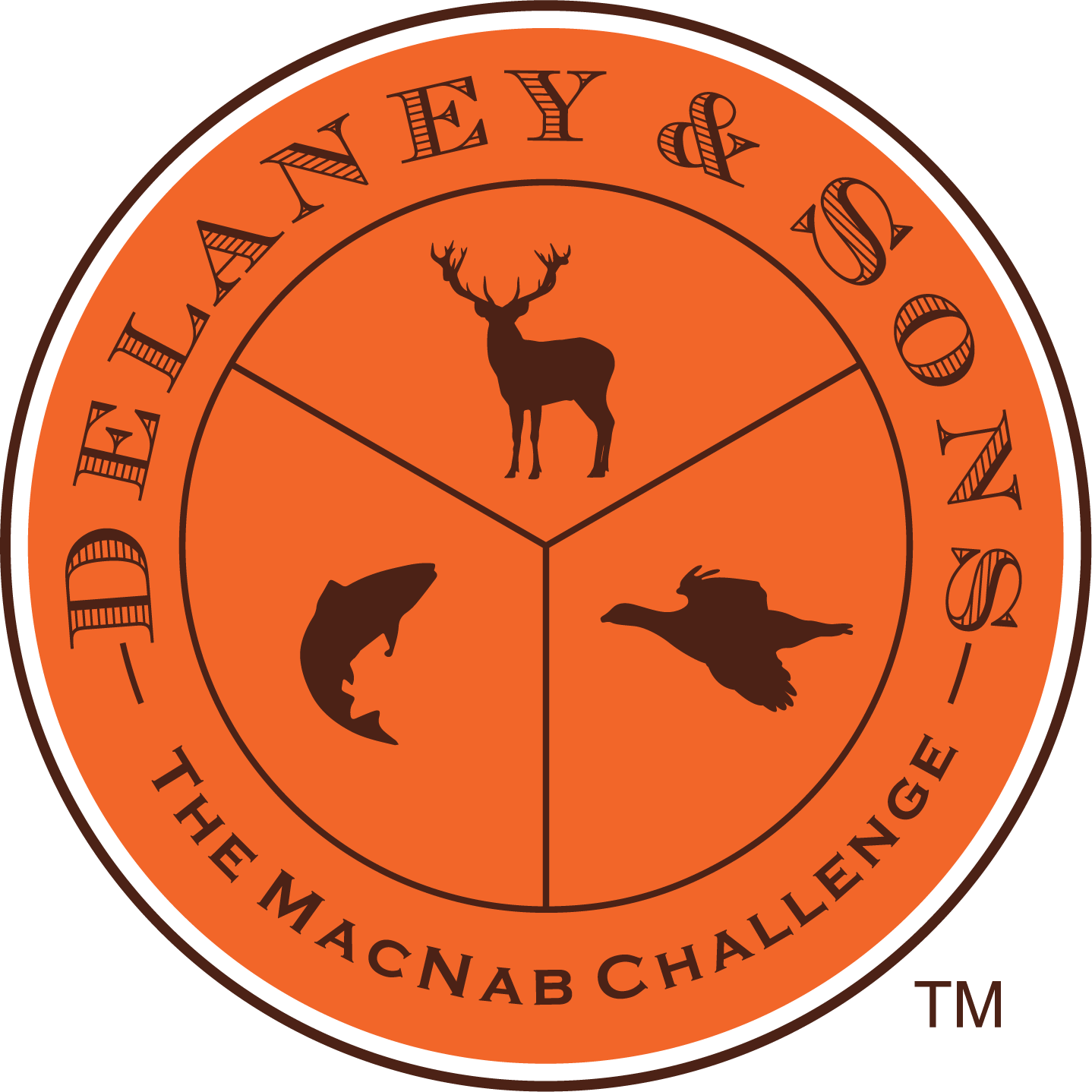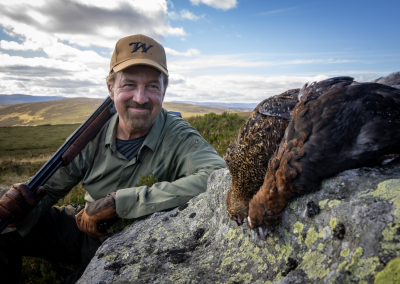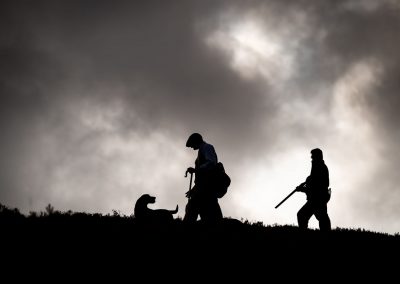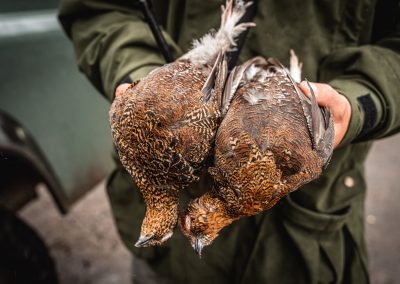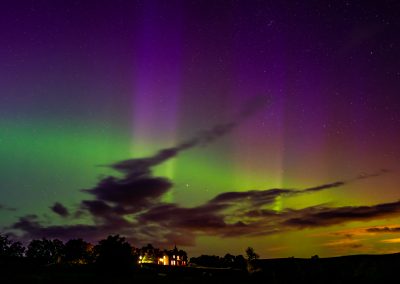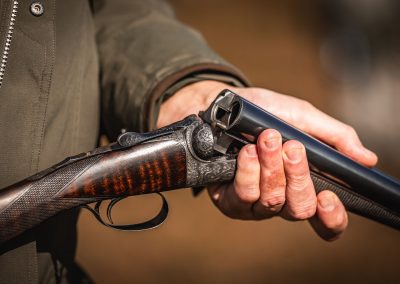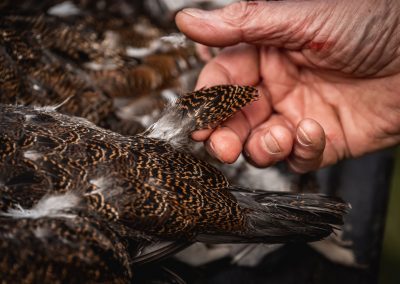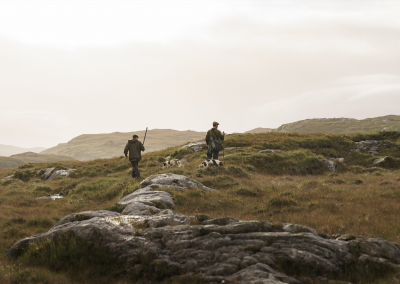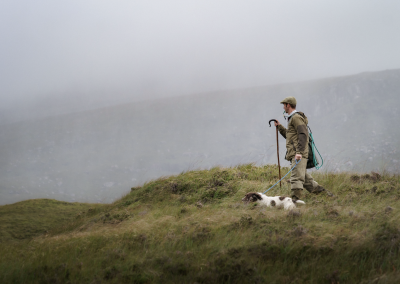Red Grouse
Walked Up Red Grouse
Red Grouse And The Macnab Challenge
The Scottish red grouse, Lagopus lagopus scotica, is an emblematic bird of the Scottish moors, intrinsically linked to the landscape, culture, and economy of the Highlands. Its vibrant reddish-brown plumage, perfectly camouflaged against the heather, and its distinctive “Go-back, go-back!” call, are quintessential symbols of the Scottish wilderness. For centuries, the pursuit of this challenging game bird has drawn sportsmen from around the globe, offering an unparalleled experience of “walked-up” grouse shooting over highly trained pointers and setters. This method, steeped in tradition and demanding both skill and physical endurance, offers a truly immersive and authentic connection to the wild Scottish environment..
Habitat: The Heather Kingdom
The survival and prosperity of the red grouse are inextricably linked to the health of the heather moorland, specifically Calluna vulgaris. This unique habitat, characterized by acidic, nutrient-poor soils and high rainfall, is the grouse’s larder, nursery, and sanctuary. Heather provides their primary food source – particularly young, nutritious shoots – vital for chick development and adult sustenance, especially during harsh winters. The structure of the heather is equally important: tall, old heather offers crucial cover and shelter, while shorter, younger heather provides accessible feeding grounds. The mosaic of different heather ages, often created through carefully managed rotational burning, is therefore critical for a thriving grouse population.
Beyond heather, a healthy grouse habitat also incorporates other elements. Patches of sphagnum moss provide essential insect life for young chicks, offering a crucial protein boost. Areas of peat bog create a diverse invertebrate population, further enriching the grouse’s diet. Critically, access to grit – small stones ingested to aid digestion – is vital for all grouse, often found in areas with exposed rock or gravelly tracks. The undulating terrain of the Scottish Highlands, with its peat hags, gullies, and rolling hills, offers natural protection and a challenging landscape for both the birds and those who pursue them.
Fragility: A Delicate Balance
Despite its robust appearance, the red grouse is a remarkably fragile species, highly susceptible to environmental changes and natural threats. Its life cycle is intrinsically linked to the health of the heather, and any significant degradation can have devastating consequences. Climate change, with its potential for increased rainfall and extreme temperatures, poses a long-term threat. Prolonged wet and cold springs can decimate chick survival rates, as young grouse are highly vulnerable to hypothermia and a lack of insect food.
Predation is another major factor in grouse fragility. Fox, stoat, weasel, and various raptors, including hen harriers and peregrine falcons, all predate on grouse eggs, chicks, and adults. While natural, unnaturally high levels can significantly impact grouse numbers, particularly where ground predator control is not actively managed.
Diseases also play a significant role. Strongylosis, caused by the parasitic nematode Trichostrongylus tenuis, is widespread and often devastating. The parasites infest the grouse’s caeca, leading to weight loss, reduced breeding success, and increased mortality. The severity of strongylosis is often linked to grouse density and habitat health, with stressed birds being more susceptible. Other diseases, such as louping ill and coccidiosis, can also impact populations.
The inherent boom-and-bust cycle of grouse populations further highlights their fragility. Numbers can fluctuate dramatically year to year, influenced by weather, disease, predation, and habitat quality. A single poor breeding season, compounded by other pressures, can lead to a significant decline, taking several years to recover. This natural variability adds to the challenge of conservation and management.
Management: A Blend of Tradition and Science
Effective grouse management is a complex undertaking, blending centuries of traditional knowledge with modern scientific understanding. The aim is to produce a sustainable surplus of grouse for shooting while maintaining a healthy and resilient population.
The core of grouse management revolves around sustainability. Estates conduct annual grouse counts, often using trained dogs, to estimate population numbers and inform shooting plans. This data, combined with information on chick survival, disease prevalence, and habitat condition, allows managers to set realistic bag limits and ensure only a sustainable proportion is harvested. In years of poor breeding, shooting may be curtailed or cancelled.
Staffing is crucial. Gamekeepers, often with generations of knowledge, are the frontline managers, responsible for habitat, predator control, and disease monitoring. Their intimate understanding of the local environment is invaluable.
Financial investment is also significant. Maintaining a healthy grouse moor requires substantial resources for staff, equipment, and habitat improvement. The income generated from shooting leases and sporting guests helps to fund these essential activities, creating a vital economic incentive for moorland conservation. Without this financial driver, many moorlands would likely be neglected, leading to habitat degradation.
The Excitement of Walked-Up Grouse Over Dogs
For the discerning sportsman venturing to Scotland, the ultimate grouse experience is the “walked-up” day over pointers and setters. This method, steeped in tradition and demanding both skill and physical endurance, offers an unparalleled connection to the wild Scottish environment. If you’re seeking a genuinely immersive and challenging sporting adventure, walked-up grouse over dogs should be at the top of your list. Unlike driven shoots, which are special in their own right, walked-up shooting involves hunting the birds in their natural habitat, often across challenging terrain.
The day typically begins with a detailed briefing from the head keeper, outlining the plan, safety protocols, and expected conditions. The team, usually a small number of guns, the keeper, and several highly trained dogs, then sets out across the moor. The pointers and setters are the stars of the show; their training is meticulous, often taking years. As they quarter the ground, noses to the wind, they methodically search for the scent of grouse.
The moment a dog “points” is one of pure anticipation. The dog freezes, often with one paw raised, body rigid, indicating the presence of birds. The guns then approach cautiously, following the keeper’s instructions. The tension builds as the birds, often unseen until the last moment, flush explosively from the heather with a characteristic whirring of wings and a burst of their “Go-back!” call. This is the moment of truth. A quick, accurate shot is required, as the grouse, low and fast, offers a challenging target. The adrenaline rush when the grouse explode from the heather is truly unforgettable.
The retrieve, carried out by another trained dog, usually a Labrador or springer spaniel, is equally important, ensuring no shot birds are left behind. The camaraderie among the guns, keepers, and dog handlers is a significant part of the experience. Shared stories, advice, and laughter punctuate the day, creating lasting memories. Imagine the thrill of working alongside expertly trained dogs, experiencing the wild beauty of the Scottish moorland firsthand.
Walked-up grouse shooting is not just about the bag; it’s about the entire experience. It’s about witnessing the incredible athleticism of the dogs, the intimate knowledge of the keepers, and the sheer beauty of the Scottish moorland. It’s a physically demanding pursuit, requiring fitness and perseverance to navigate the undulating terrain, often through deep heather and over boggy ground. The weather, famously unpredictable in Scotland, adds another layer of challenge and excitement.
Beyond the thrill of the chase, walked-up shooting offers a deeper appreciation for the wild Scottish grouse and its habitat. It provides a direct insight into the intensive management required to sustain these iconic birds and the fragile ecosystem they inhabit. For the responsible sportsman, it is an opportunity to participate in a centuries-old tradition, contributing directly to the conservation of a unique and cherished landscape. If you seek an authentic connection to wild Scotland and a truly sporting challenge, this is the grouse shooting experience for you. The taste of a wild Scottish grouse, ethically harvested and prepared with care, is the perfect culmination of a truly unforgettable day on the moors.
In conclusion, the wild Scottish grouse is more than just a game bird; it is a symbol of the untamed beauty and ecological richness of the Scottish Highlands. Its existence is a testament to the delicate balance of nature and the dedicated efforts of those who strive to conserve it. For sportsmen, the pursuit of grouse over dogs offers not only an exhilarating challenge but also a profound connection to a landscape steeped in history and tradition, a privilege and a responsibility that ensures the future of this magnificent bird for generations to come.
We'd Love To Hear From You
Take Up The Challenge
If you've thought about spending a week in Scotland hunting, this is the year to do it! Don't hesitate to reach out to us. We are happy to discuss logistics!
What Our Travellers Say
This is a Sportsman’s ultimate challenge. The Delaney and Sons team has made the opportunity a reality. And in the thick of it you realize it is exhausting as the Highland grounds are more rugged than imaginable, the Chase is fair, and while the river pools are fishable the Salmon need to be in the mood. And if you are not mentally prepared during the week, you will happily settle for an accomplishment a day with superb meals and great camaraderie, but not come close to completing the MacNab which is why you signed up. The Outfitting team is prepared, flexible, and accommodating – as are the Estate’s hunting/fishing teams and lodge support teams, but it is up to the Sportsman and his attitude to make it happen.
3 Species In A Single Day
The toughest hunting challenge in the world
experience the tradition, community, adventure and fun!



Connect with Us
Call Us Today
+1 717.418.8575
+1.717.919.5317
About Delaney & Sons
We are a family operated travel business with great reverence for driven shooting and the MacNab Challenge. We are passionate about sharing the tradition, community, adventure and fun of authentic British and European fieldsports with you! Come with us!
